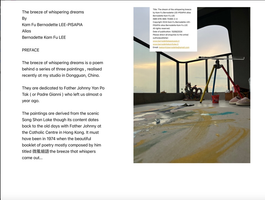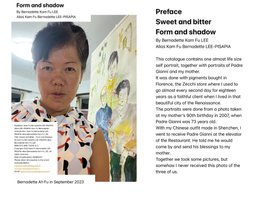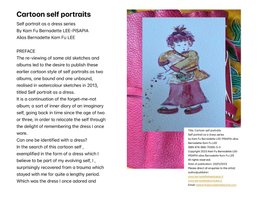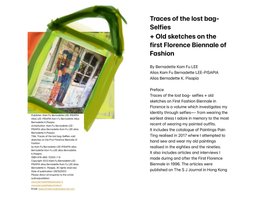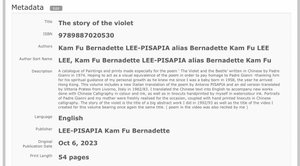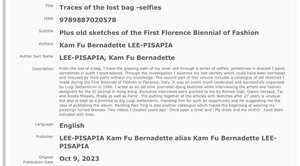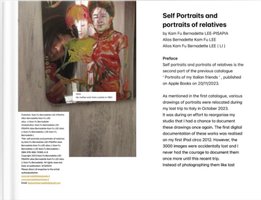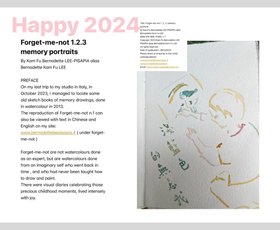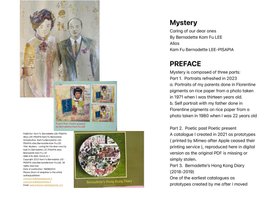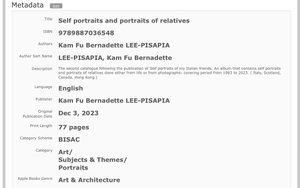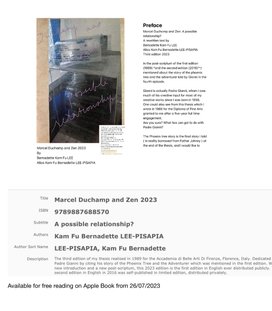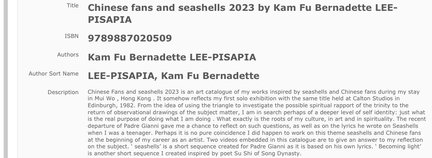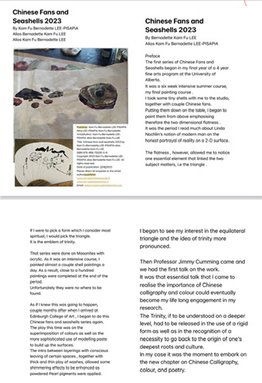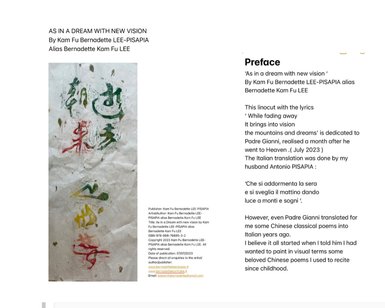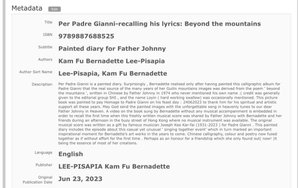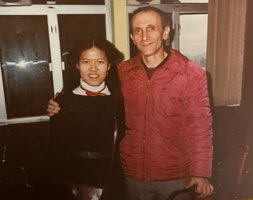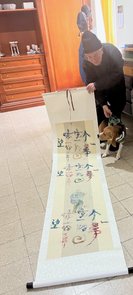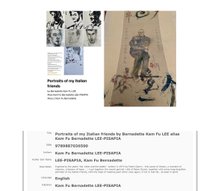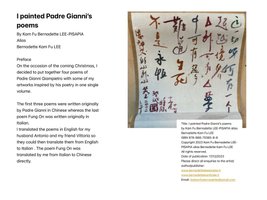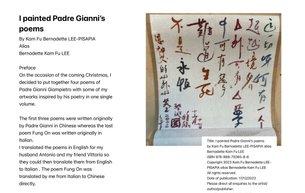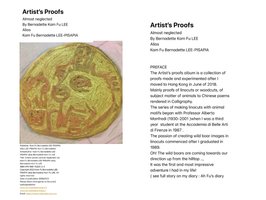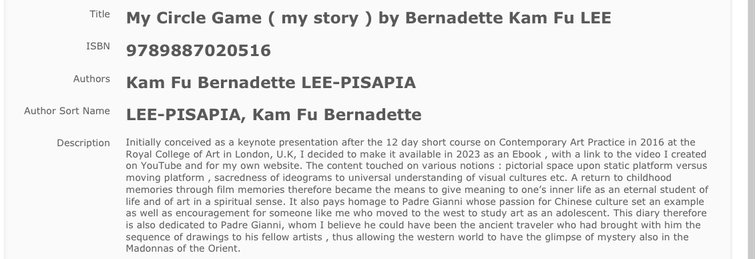BERNADETTE , known as
Bernadette Kam Fu LEE
as well as Kam Fu Bernadette LEE-PISAPIA , A FINE ARTIST and a Self-published author
Art , not for sale except for prints and artist books solely handled by Laboratorio Fratelli Manfredi.( previously known as Mavida)
Bernadette does not sell her pieces since her retrospective in Florence ( 1983-1993, Grande Quadri. Quadri Invendibili)
whoever sells you works by Bernadette after that date could be of stolen pieces.
Kindly inform Bernadette via email: leekamfubernadette@pec.it
Bernadette’s diary-
37th book on Apple Books for free reading:
The dream of the whispering breeze ( The breeze of the whispering dreams)
10/06/2024
ISBN 978-988-70365-2-4
39th volume: Dongguan, my father's hometown, published 19/09/2024
5 August 2024 is a video I realised on ' My trip to Venice' which covers the Venice Biennale 2024 -" Foreigners everywhere'- and the exhibition on De Kooning L'talia ( Gallerie dell'Accademia di Venezia)
photos 40 years later:
with Padre Gianni in Dec 1983, Hong Kong
with Don Italo. Mazzano Romano, Oct 2023
on Apple Books
for free reading
under author:
Last name: LEE-PISAPIA
first name: Kam Fu Bernadette
LEE-PISAPIA Kam Fu Bernadette or LEE Kam Fu Bernadette
( order of name used in Hong Kong and Italy
alias
Kam Fu Bernadette LEE-PISAPIA ( alias Kam Fu Bernadette LEE PISAPIA)
(order of name used in Britain, Canada )
alias
Bernadette Kam Fu LEE ( maiden name)(artist name)
LEE-PISAPIA, Kam Fu Bernadette
(order and form ( with a comma in between ) generally used in Hong Kong to distinguish
last name from first name)
Kam Fu Bernadette LEE-PISAPIA
(order generally used in Britain and Canada )
penname: Bernadette K. Pisapia, Kam Fu Pisapia, Lee-Pisapia Kam Fu Bernadette
Bernadette is the writer as well as the publisher
the name chosen for the publisher ( not a registered company ) has two
formats:
LEE-PISAPIA, Kam Fu Bernadette ( Hong Kong format), or LEE-PISAPIA Kam Fu Bernadette ( Italian format) . Therefore, the comma in between does not mean two distinct individuals as it is used to distinguish the last name and the first name in the Hong Kong format. For the other format, capital letter has been used to indicate the LAST NAME from the first name.
( from 06/09/2023, the Italain format is officially transformed to LEE Kam Fu Bernadette coniugata PISAPIA . However, the fully extended writing of my hyphenated Last Name is still maintained as my Canadian and Hong Kong identity : Kam Fu Bernadette LEE-PISAPIA)
NOTE:
email : ahfu@bernadetteleepisapia.it has previously been compromised and therefore please use the email:
kamfubernadette@icloud.com or leekamfubernadette@gmail.com to contact me.
Thank you.
Bernadette
05/05/2023
Hong Kong
student name used in Italy:
LI (last name)
Kam Fu Bernadette ( first name)
videos Per Padre Gianni can be viewed on my other website:www.bernadetteleepisapia.it especially realised by Bernadette for the family of Padre Gianni in Mazzano Romano and Capranica, Italy, thanking them for their hospitality
Bernadette at her Noguchi inspired space
Noguchi 的休止符
想不到,竟然在這銀河灣畔住上了一年。剛到梅窩此居址時,所有的精神也是集中於Noguchi 的創作意念處:如何活出Noguchi的自然關係式空間。他那種合一的空間,是基於那關係式空間的注重;物與物之間的連接或非連接的留空是一種大自然式的表達。
在大自然裏,樹枝的接連處是大自然生長的「自發」接口,所以,當我們看見雕塑接口有點兒不對稱的時候其實是由於其非為大自然自然生長的規律所成。這個深入的心得,在我上第一課雕索課程已體驗得到。那是Peter Hide 教授的精警句語。
Noguchi 的作品,其偉大處不應止於Noguchi 作品本身,而是伸展到作品跟作品的連接性無形空間。這種空間是有形的無形。其有形處應該是突破了雕索本身的個體美感;基於這非形體實質的滲入個體與個體的空間;個體於是變成整個空間的一小部分,但卻是個有附和韻律的個體,奏著的旋律是與別的個體旋律有著互相的默契及適當的節拍。當然,那所謂個體與個體的空間便是「休止符」,一個靜待有時間的「休止符」。
當不同的「休止符」即不同的無形空間設置變成視覺式的「休止符」,所有在場的個體也因為這種不相同的無形旋律改變了個體式原本的韻律,變得有了呼吸,一種個體本來不能擁有的呼吸。因為,只要你將其中一個個體移走時,將之置於一個沒有Noguchi 的整體空間意念的環境裏,你所感受到的竟然是為何那個體有點兒「睡著了」。這個「睡美人」,在Noguchi悉心安排放置後,將之加上無形空間的保護式空氣後,此睡美人竟會立即睡醒起來;你開始會聽到她的呼吸,接而是她的旋律,接著是她如何跟別的個體打個招呼。於是,一個Noguchi 式的空間,就是如許的誕生了。那是一個交響樂呼吸的自然空間。
所以我一直在懷疑,Noguchi 為何是首位成立自己博物館的當代藝術家。因為,他必須將每一個睡美人給予那無形的保護「休止符」,好等她們都能剛剛睡醒起來,唱著剛甦醒的美麗旋律,令人一進入那整體正在旋奏美律的環境裏,都變成跟睡美人般,呼吸著整體旋律的創作靈氣。
住了這銀河灣畔一年,最感興幸就是每天跟Noguchi 的睡美人會面。而每當睡美人們得不到適當休止符的保護時,我們即感覺到空間的侷促感。
所以,很感謝Noguchi 的合一概念及其休止符的保護空間。
Bernadette 李錦芙寫於銀河灣畔Noguchi 創作睡美人作品間
二〇一九年七月二十四日
Time flies.
One year has passed since I came to make my artist residency at Riverwalk.
Right from the beginning, Noguchi has been my main point of inspiration, especially in his particular idea of space.
This particular concept derived from a deep understanding of Nature places attention on inter-related space.
The idea of wholeness or integrated unity comes before the idea of single entity.
Inter relationship between entities and how each single unit is being related to another seems to override the devotion usually dedicated to one piece of art work in its own right.
This understanding of the active use of empty space , the in-between space found between art pieces derived from nature is evident.
Even the point of contact between any two elements, for instance, if we happen to find it out of balance, it could possibly due to a lack of understanding towards how Nature operates.
Take the example of the connecting point between the trunk of a tree and its branches, it is natural in the sense that it is not a contrived action, as we sometimes find in arbitrary solutions of certain less successful art pieces.
This lesson of profound understanding of the natural growth of nature and the necessity to apply it in a sculptural piece was a lesson I learned as a young Fine Arts student and never forgot.
It came from my professor Peter Hide who once commented a piece of work of a colleague,
‘ Somehow this doesn’t look quite right... maybe because you don’t see that in Nature...’
Coming back to Noguchi, we can say that the strength of his Art pieces lies not only in the Art pieces themselves, but also on the relationship he consciously activates among the pieces.
This spatial relationship is special in the sense that it is a formless form, just like another sculptural piece created by Noguchi himself.
What this formless space does is to introduce a catalyst in such a way that the essence of each single art piece is quickly enhanced, so much so that each piece lives alive with its own essential spirit, yet at the same time seen as a lesser self. So essence overrides form, and wholeness comes before parts.
To paint this spatial idea of Noguchi’s works, one can compare this spatial unity to a well played musical piece.
The empty space is like the moment of silence designed by the musician in playing his piece. The subtle injection of an almost seemingly missing yet present pause , when played according to the true intention of the composer, the piece of music all of a sudden becomes the natural beating of a heart, the natural flowering of a flower, the natural realisation of a self...
When this pause of a musical piece is not respected, then the piece seems not to be able to perform its natural flowing of heart. In Noguchi’s works, that pause is the inter between spaces he designs for his pieces.
And each single piece, when not put together with the pause he desires for them, each single piece is likened to a sleeping beauty, waiting for the musician Noguchi to re-establish the formless form of space, in order that the sleeping beauty will suddenly stay awake, breathing the most beautiful breath-the essence of spiritual self.
When all the sleeping beauties in the space are fully alive, thanks to the subtle in-between-space orchestrated by Noguchi, we will find the musical piece plays its heavenly music.
I , therefore, often wonder why Noguchi is the first contemporary artist who established and found his own museum during his lifetime.
It could possibly due to his desire to play his musical piece of sculptures in the manner he desires: the introduction of that silence space, vital for his dream of bringing an eastern yet western vision in the manner of Nature.
Thank you Noguchi. You made my stay at my space meaningful.
( I created myself an artist in residency project since July 23 of 2018 in my apartment at Riverwalk of Mui Wo, with the purpose of re-establishing the connection with Nature through the Pieces of creations I bought of Noguchi. This approach of seeing through the eyes of Noguchi is a second chapter I am writing after the first chapter I wrote on Chinese ideograms, Calligraphy, Western pictorial traditions, and poetry, a research I began in 1982-1983, during my Postgraduate program at Edinburgh College of Art, Scotland)
Bernadette
at Riverwalk, a year after she moved to Mui Wo,
among the artpieces of Noguchi at her space
25/07/2019
Condividi questa pagina
